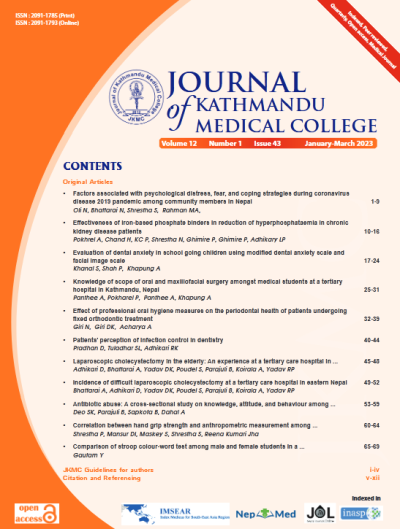Incidence of difficult laparoscopic cholecystectomy at a tertiary care hospital in eastern Nepal
DOI:
https://doi.org/10.3126/jkmc.v12i1.56692Keywords:
Cholecystectomy, Cholecystitis, Gall bladder Disease, LaparoscopyAbstract
Background: Laparoscopic cholecystectomy (LC) is the gold standard modality for the treatment of gall bladder diseases. Sometimes LC needs to be converted to open due to intraoperative complications. A few factors like age, body weight, comorbidities, ASA score, and surgeons’ experience will warn about the possible complications and need for conversion to open. Prior prediction of the difficulties will warn the surgeon to prepare accordingly. The patient’s family will also be counseled regarding it.
Objectives: To identify the possible factors for predicting difficult LC.
Methods: This was a descriptive cross-sectional study conducted in the general and laparoscopic surgery department at Nobel Medical College Teaching Hospital, Biratnagar, Nepal. Simple random sampling technique was utilised in this retrospective analysis. Data were taken from 2021 May to 2022 May after institutional ethical clearance. Descriptive statistics were assessed done using SPSS v.26.
Results: A total of 230 cases were included and analysed in the study. The incidence of difficult LC was 17.8%. An overall conversion rate of LC to open cholecystectomy in difficult LC was seen in 1.3% of the cases. Intraoperative complications were not seen in 87.8% of the patients. The mean duration of hospital stay in difficult LC cases was five days.
Conclusion: Predicting difficult LC will not only warn surgeons to be prepared for the possible difficulties but will also help in counseling patients’ families regarding the intraoperative complications and the possible need for the conversion to open.
Downloads
Downloads
Published
How to Cite
Issue
Section
License

This work is licensed under a Creative Commons Attribution-NonCommercial 4.0 International License.
Copyright © Journal of Kathmandu Medical College
The ideas and opinions expressed by authors or articles summarized, quoted, or published in full text in this journal represent only the opinions of the authors and do not necessarily reflect the official policy of Journal of Kathmandu Medical College or the institute with which the author(s) is/are affiliated, unless so specified.
Authors convey all copyright ownership, including any and all rights incidental thereto, exclusively to JKMC, in the event that such work is published by JKMC. JKMC shall own the work, including 1) copyright; 2) the right to grant permission to republish the article in whole or in part, with or without fee; 3) the right to produce preprints or reprints and translate into languages other than English for sale or free distribution; and 4) the right to republish the work in a collection of articles in any other mechanical or electronic format.




